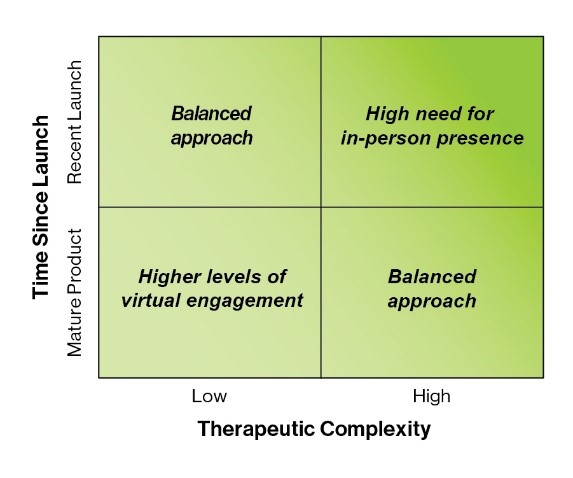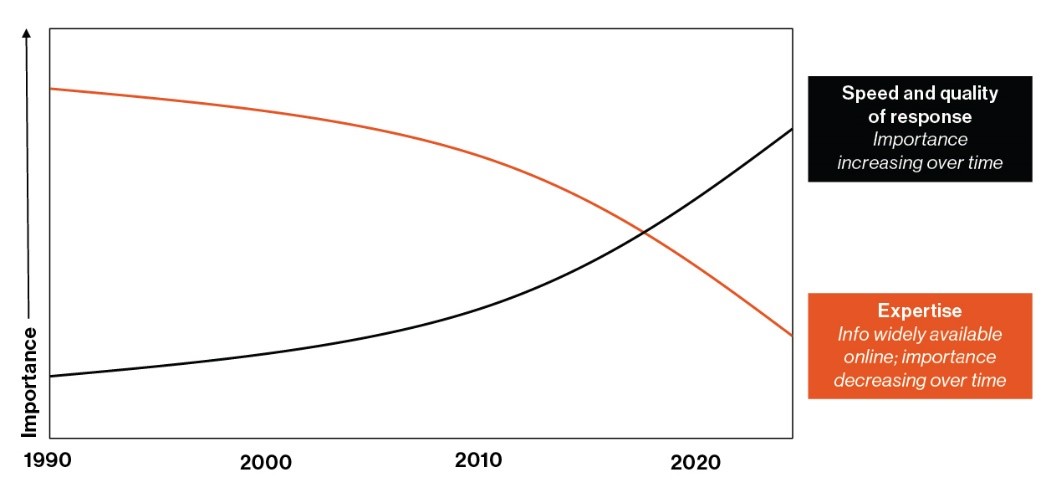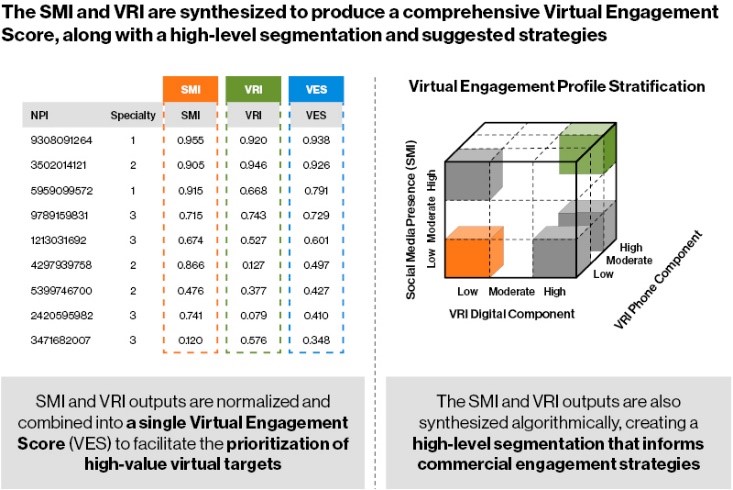Information symmetry between field sales representatives and customers has arrived. In most cases, healthcare providers can remotely (and more conveniently) access the same data that pharmaceutical field representatives can present in person. They also can request a visit from a medical science liaison and order samples. All with the touch of a screen.
So why does the pharmaceutical industry continue to rely heavily on an old-fashioned sales model?
While face-to-face interactions still carry value—particularly for new biologics or cell and gene therapies with complex procurement and reimbursement pathways—in most cases, maintaining an extensive traveling field team in today’s virtual world requires significant resources. Instead, pharmaceutical field leaders should embrace the contemporary opportunities—and soon—to optimize their field strategies, better serve prescribers and patients, and gain competitive advantage.
 Accelerated Reality Enables Precision Targeting
Accelerated Reality Enables Precision Targeting
Even before the COVID-19 pandemic forced a sudden and seismic shift in how field teams conduct business, field access to and influence on prescribers had been declining for decades as more stringent compliance guidelines and regulations ratcheted up restrictions and customers themselves increasingly closed the door on industry engagement. In fact, for most therapeutics, there is little that a pharma sales rep can detail healthcare providers on, outside of the preapproved and readily available product information, without potentially jeopardizing compliance.
In other words, COVID-19 did not shift the paradigm so much as accelerate the inevitable. It’s in the best interest of commercial leaders to understand that prescribers will continue to prioritize minimizing unessential visitors over inviting relationship-building field reps back into the office. And many of the largest hospital and clinic systems may not remove the increased COVID-era restrictions at all.
However, with the ever-growing availability of comprehensive claims data, the advent of machine learning, and the evolution of social media analytical capabilities, the opportunity to calibrate your field model and take full advantage of predictive analysis and virtual engagement is knocking hard. So, open the door and consider implementing the following forward-looking strategies.
1. Emphasize Agility Over Proximity
Back in the days before healthcare providers had ready access to information, they sought and valued knowledgeable pharma reps who could keep them up to speed and help them understand the latest therapies. The best of those reps helped differentiate and drive preference for the products and companies they represented. Now, that information is easily available to consume, which has shifted the priority from field sales depth of knowledge to the quality and speed of response. This gives field leaders significant leeway in how they design a team. Those with vision and economic prudence will see the value in creating an agile field team capable of shifting course quickly to meet the needs of product milestones, advances in research and development, and changing market circumstances—all anchored on and informed by rich data and analytics.
 Admittedly, in concept, this goes against the current thinking and longstanding political climate within many pharmaceutical companies. And understandably few brands or franchises will volunteer to reduce their field force while on the hook for hitting annual revenue goals. Not to mention the potential reckoning from a field team wary of being disrupted.
Admittedly, in concept, this goes against the current thinking and longstanding political climate within many pharmaceutical companies. And understandably few brands or franchises will volunteer to reduce their field force while on the hook for hitting annual revenue goals. Not to mention the potential reckoning from a field team wary of being disrupted.
However, field mavericks should consider the benefits of piloting an agile force regardless of where a drug is situated in the product lifecycle. With an elite, agile field force, pharmaceutical companies can optimize teams to only include the best of the best who are capable of delivering value across multiple therapeutic portfolios—and off better incentives to attract and retain the best talent—all while reducing overall costs and better serving customers. For those brave enough to embrace this future state, the right-sized upsides are strategically positioned to far outweigh the risks.
2. Rethink Targeting and Embrace Ascendant Digital Capabilities
As noted above, advances in digital technologies and communication strategies were taking over long before the coronavirus pandemic restricted travel and visits. Those pharmaceutical company field leaders that thoughtfully embrace and nurture this momentum can gain a significant advantage. One of the newest strategies is to harness the respective powers of comprehensive claims data, machine learning, and social media analytical capabilities to optimize targeting plans and prioritize the channel mix by customer segment.
 This methodology leverages social media data to identify and quantify key defining characteristics of healthcare providers active on social media and in other online environments. This social media index (SMI) is cross referenced with a virtual receptivity index (VRI) that uses advanced machine learning to build a model of healthcare providers prioritized by their likelihood to respond to virtual outreach.
This methodology leverages social media data to identify and quantify key defining characteristics of healthcare providers active on social media and in other online environments. This social media index (SMI) is cross referenced with a virtual receptivity index (VRI) that uses advanced machine learning to build a model of healthcare providers prioritized by their likelihood to respond to virtual outreach.
By embracing the digital age, leveraging machine learning and predictive social media analysis, pharmaceutical companies can better optimize personal and nonpersonal promotions. A statistically relevant correlation exists between a person’s level of social media activity and likelihood of engaging virtually. In one recent case, analysis showed the mean email open rate for healthcare providers with a LinkedIn profile was 49% higher than those without one. Likewise, the mean email open rate for healthcare providers with a Twitter profile was 74% higher than those without one.
Using this model, pharma leaders can allocate resources and develop outreach strategies and plans more astutely. For example, consider the following pandemic-era case scenario. Experiencing steady declines in sales to some of its customers, a pharmaceutical company conducts social media and machine learning-based virtual engagement analysis. Results reveal one of its pre-pandemic largest prescribers never responds to virtual engagement efforts, including emails from reps, invites to webinars, etc. However, another of its high-volume prescribers who never previously welcomed face-to-face meetings is highly active on LinkedIn, and possesses characteristics that make them more likely to attend industry webinars and open emails. By understanding these customers’ preferences, the company can shift gears accordingly and tailor engagement approaches—and resources—with a much higher probability of success.
3. Commit to Responsive, On-demand Engagement
With that in mind, responsive, on-demand engagement is another piece of the commercial model that will become increasingly critical to success, particularly as field teams become leaner and more agile. This means, for example, when customers have questions about a product—even something as simple as “is this covered by such and such insurance”—they can expect to engage with a qualified representative on-demand and get answers in as close to real time as possible, whether through a virtual chat session, text message, phone call, or other expeditious means.
While pharmaceutical companies have some mechanisms in place for this, engagement still tends to anchor on relationships between field reps and healthcare providers and lack the efficiency and streamlined process customers in most other industries now expect. The rest of the contemporary world works in near real-time, and the pharma companies that best deploy this kind of quick-turn, reliable service will build long-term advantages over competitors. In fact, this is already playing out in the market. In one recent case, a large biopharma with a first-to-market treatment for a neurological condition was taken by surprise when six months later an undifferentiated competitor launched, focusing on a superior customer experience, and quickly matched its market share.
Maximizing Sustainable, Future-State Strategies
As the pandemic (hopefully) begins to subside, pharmaceutical organizations can anticipate that some traditional face-to-face interaction will return and in certain cases will continue to be the preferred method of engagement both for the customer and supplier. However, assuming a return-to-baseline accessibility to providers is unrealistic and unsustainable. Forward-thinking organizations will look to deploy agile, fit-for-purpose field teams and supplement them with virtual support, backed by predictive analytics to better meet modern customer needs.
The fact is the window for traditional access to prescribers has been gradually closing for 20 years. The companies that are ready to adapt to this reality will find efficiencies, evolve more rapidly than competitors, and be on the leading edge of change, rather than lag behind and squander resources.







